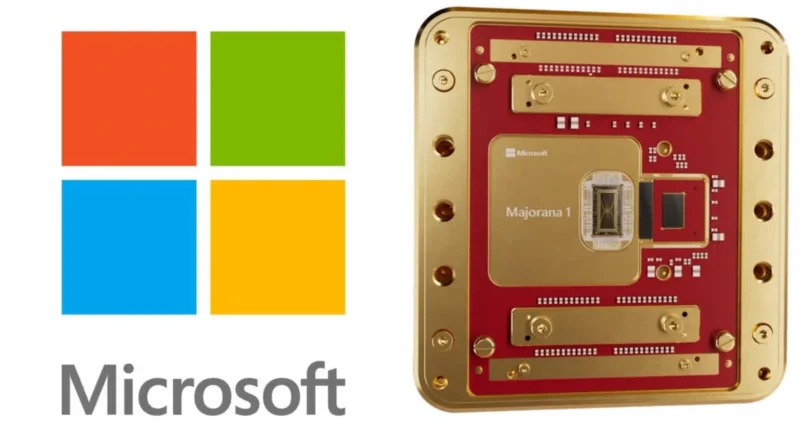Microsoft Ushers in a Quantum Revolution: Unveiling the Majorana 1, the World’s First Topological Qubit Chip
The terrain of quantum computing has been forever changed with the news from Microsoft of a revolutionary breakthrough: the development of the Majorana 1, the first quantum chip in the world to use topological qubits. This epochal breakthrough is not only an opening chapter on quantum technology but also brings humans closer to discovering the full capability of machines to solve problems that are said to be insurmountable for classical computers. By harnessing a whole new category of materials called topo conductors, Microsoft has designed a quantum chip that bypasses many of the vulnerability and scalability issues that haunt conventional qubits—precipitating what experts describe as the “topological era” of quantum computing.

The Dawn of Topological Qubits: A Game-Changer for Quantum Stability
The core of Microsoft’s achievement is the topological qubit, a new method of quantum computing that leverages the unusual properties of so-called Majorana fermions, exotic quantum particles. In contrast to standard qubits—based on superconducting loops, trapped ions, or photons—topological qubits rely on the physical robustness of their structure itself for stability. These qubits encode information in the coordinated motion of electrons along the boundaries of specially designed materials, where interference from heat or electromagnetic waves finds it difficult to disturb their quantum state.
Microsoft’s Majorana 1 chip does this with topoconductors, materials specifically designed to harbor Majorana fermions at close to absolute-zero temperatures. These particles, originally hypothesized in 1937 by physicist Ettore Majorana, have a special “self-checking” property: their quantum states are shielded by their topological geometry, rendering them naturally immune to the decoherence and errors that afflict other qubit designs. Scientists grappled for decades to demonstrate their existence, much less control them. Now, Microsoft’s researchers have not only stabilized Majorana fermions in a laboratory setting but also incorporated them into an operational chip—a milestone previously thought to be decades away.
Why Topological Qubits Matter: Solving Quantum Computing’s Achilles’ Heel
Today’s quantum computers are confronted with a stark stumbling block: error rates. Even the cutting-edge superconducting qubits of IBM and Google need error-correction mechanisms that use enormous quantities of physical qubits to produce one reliable “logical qubit.” This inefficiency raises scaling quantum systems to industrial importance to an unfeasible level of complexity. Microsoft’s topological qubits, on the other hand, are inherently resilient to errors. Their topological structure guarantees quantum information is stored globally, and not in local particles, which enables the system to “self-correct” small perturbations.
The stakes are high. While current quantum chips require elaborate cooling schemes and labor-intensive error correction, the Majorana 1 may slash the overhead required for dependable computation by a significant margin. Initial simulations predict topological qubits could maintain error rates of up to 1,000 times lower than superconducting qubits. This advance could speed the window for practical quantum computers that can solve real-world problems—from synthesizing life-saving medicines to refining global supply networks.
From Lab to Reality: The Science Behind Microsoft’s Breakthrough
Designing the Majorana 1 involved a multidisciplinary collaboration across quantum physics, materials science, and nanofabrication. Microsoft’s researchers worked with academic experts to grow topoconductors, hybrid materials made of superconductors and semiconductors such as indium antimonide. When cooled and subjected to a magnetic field, the materials create one-dimensional wires in which Majorana fermions appear at their ends. By carefully controlling these conditions, scientists choreographed the fermions’ interactions to create stable qubits.
The chip itself runs at temperatures slightly above absolute zero (-273°C), like current quantum systems. But its design makes it easier to scale. Conventional qubits need complicated arrays of control lines and shielding, but topological qubits can be packed tightly and controlled with electric fields—a property that could one day lead to smaller, more energy-efficient quantum processors.
Industrial-Scale Quantum Computing: What’s Next?
Microsoft envisions the Majorana 1 as the foundation for a future quantum supercomputing ecosystem. By integrating topological qubits with classical Azure cloud infrastructure, the company aims to democratize access to quantum-powered solutions. Industries stand to gain immensely:
- Pharmaceuticals: Simulating molecular interactions for drug discovery.
- Logistics: Optimizing routes and supply chains in real time.
- Climate Science: Modeling complex systems like carbon capture materials.
- Cryptography: Developing unbreakable encryption protocols.
But challenges persist. Scaling from a single qubit to thousands—and control and connectivity maintained—will take years to refine. Microsoft’s next major milestone, an entirely error-corrected logical qubit, is planned for 2025. “This isn’t the finish line; it’s the starting gun,” said Dr. Chetan Nayak, Microsoft’s Quantum VP. “But for the first time, we have a viable path to quantum machines that deliver real-world value.
The Quantum Race Heats Up
Microsoft’s announcement fuels competition in the global quantum space. Rivals such as IBM and Google concentrate on advancing superconducting qubits, and startups are working on photonic or neutral-atom solutions. Microsoft’s topological gamble makes it a leader in fault-tolerant quantum design. Governments also spend lavishly, with the EU and U.S. setting aside billions to develop quantum technology.
Critics warn that topological qubits remain untested at scale. Yet the success of the Majorana 1 in stabilizing Majorana fermions indicates that the theoretical is finally real. As industry analyst Olivia Harper puts it, “Microsoft just changed the narrative. The question is no longer if topological quantum computing will work—it’s when.”
A Paradigm Shift in the Making
The Majorana 1 is more than a technological breakthrough—it’s a revolution. By leveraging the quirks of quantum topology, Microsoft has jumped over obstacles previously thought to be insurmountable, catching a glimpse of a world in which quantum computers function not as delicate laboratory toys, but as sturdy instruments fueling human innovation. As the era of topology dawns, one thing becomes certain: the quantum revolution now has its accelerant.
Tune in as Microsoft speeds toward a world where the impossible is made possible by computation. The era of quantum utility is coming—and it’s founded on topology.
Click Here to subscribe to our newsletters and get the latest updates directly to your inbox

